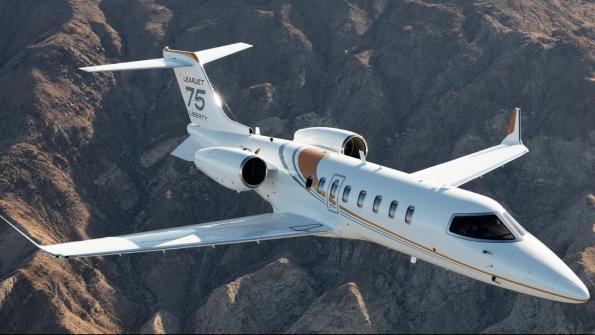
WICHITA—It’s the end of an era. Bombardier has announced it plans to cease production of its Learjet 75 Liberty at the end of 2021 to concentrate on its more profitable Challenger and Global brands and cut global employment as it works to reduce $400 million in costs each year.
The move brings to a close the production of the Learjet brand, which began in 1963 with the Learjet 23–the most iconic civilian jet on the market–drawing customers such as Frank Sinatra and the Rat Pack. In the early days, the name Learjet became generic for any private jet, as Kleenex is to tissue, Vaseline is to petroleum jelly or Velcro to hook and loop.
The move is a blow to Wichita, which issued its first industrial revenue bonds to help Bill Lear build the facility here. Lear set up shop in Wichita because he knew he could find the workers he needed to bend metal.
“This is a decision we did not take lightly,” Eric Martel, Bombardier president and CEO, told analysts Feb. 11 on a conference call. With more than 3,000 Learjet aircraft built, “Learjet has had a remarkable and lasting impact on business aviation.”
But given the number of new entrants in the light jet segment and the challenging market dynamics, Bombardier must focus its future efforts on the more profitable Global and Challenger families, Martel said.
Bombardier’s Wichita site will become a Center of Excellence for special mission aircraft and continue to serve as Bombardier’s primary flight test service. It is also part of the company’s broad service network.
“Wichita is a very important site for us,” Martel told reporters. “I’m not saying this lightly.”
The decision was not a big surprise to analysts and experts, given low production rates of the Learjet 75 Liberty, the final Learjet in the company’s product lineup. The competition has been strong with the Embraer Phenom 300, Citation CJ4 Gen2 and Pilatus PC-24. In 2020, the company delivered 11 Learjets, compared to 12 in 2019.
Bombardier will continue to support the more than 2,000 Learjet aircraft flying today, Martel said. To that end, it is launching what it calls a Learjet RACER manufacturing program for the Learjet 40 and Learjet 45 aircraft. The program includes a set of enhancements, including interior and exterior components, new avionics, high-speed connectivity, engine enhancements and improved aircraft maintenance costs, it said. It will be offered exclusively at Bombardier’s Wichita service center.
Bombardier is in a transition year following the divestiture of its rail business, the final step to a business jet focus as a pure play company. In 2021, its focus is to execute its productivity actions, further mature Global 7500 production and begin to address its capital structure, Martel said. It plans to generate $400 million a year in recurring savings by 2023. Savings are expected to total about $100 million in 2021.
Plans include consolidating aircraft completion to Montreal and reviewing options for underused industrial space.
Company-wide, it plans to cut 1,600 positions and end 2021 with a global workforce of about 13,000, Martel said. The cuts will include 700 employees in Quebec, 100 in Ontario, and 250 in Wichita, with the remainder coming from other sites. Most of the cuts will include management and office positions. In Wichita, however, the reductions will mainly include workers on the shop floor.
“Workforce reductions are always very difficult, and we regret seeing talented and dedicated employees leave for any reason,” he said. “But these reductions are absolutely necessary for us to rebuild our company while we continue to navigate through the pandemic.”
The past year was difficult for Bombardier, the industry and individuals, Martel said. During the COVID-19 pandemic, the company reset production rates and its global supply chain, took steps to reduce costs, moved to protect the health of its employees and supported government mandates to slow the spread of the coronavirus, Martel said. It was a “massive undertaking,” he said.
In 2020, Bombardier delivered 114 business aircraft, including 44 in the fourth quarter, compared to 142 in 2019, a decline of 28 aircraft. Deliveries in 2020 included 59 Global, 44 Challenger and 11 Learjet aircraft. Fourth-quarter results also included a record 16 Global 7500 ultra-long-range aircraft. Global 7500s delivered in 2021 will begin to make a profit for the company as the learning curve improves, number of production hours declines and pricing improves.
Bombardier predicts 2021 deliveries to be in line with those in 2022, with a forecast of 110 to 120 deliveries.
In its orders, the company saw positive momentum in the fourth quarter. But it is difficult to predict when a full-market recovery will occur, he said. That will not happen until borders reopen and international travel restrictions are lifted.
Business aviation revenue rose 3% in 2020 to $5.59 billion from $5.42 billion in 2019, driven by the continued increase in Global 7500 deliveries. Business aviation manufacturing revenue rose 11% in the year from Global 7500 market gains, while services revenue declined 21% to $988 million.
Its business jet order backlog totaled $10.7 billion at the end of 2020, down 26% from $14.4 billion in 2019.
Editor's note: The story has been corrected to reflect that the Learjet was the first iconic civil aircraft, but it was not the first civilian aircraft. The Lockheed Jetstar, North American Sabreliner, DeHaviland Comet and Boeing 707 came before it. In addition, Elvis Presley owned a JetStar.






Comments
And possibly there will be buyers for the marque and even the the aircraft designs.
Will Bombardier make an airliner version soon of its Global 7500?